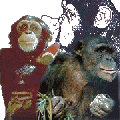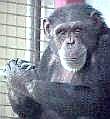| Linguistics 105 * Words and Sounds |
| Lecture Number Eighteen |
 Language Acquisition Among Pongids
Language Acquisition Among Pongids
|

- Recall Hockett's "Design Features"
- Common features: medium/mode, semanticity (X = Y), function
- Higher features: reciprocity, parental/cultural transmission, arbitrariness (not iconic), discreteness of elements, locational displacement
- Highest features: temporal displacement, categorical abstractions, generative
grammar, recombinacy
- Non-Pongids in the
Wild
- Prosimians -- symptomatic vocalization
- Vervets (monkeys (anthropoids))
- three calls
- eagle call (look up, run to bushes)
- snake call (look down, hold up arms)
- large mammal (climb (higher) in trees)
- innate + learned -- babies make all three instinctively
- some initial confusion
- eagle call for all birds
- large mammal call for all mammals
- three calls
-
Pongids
- Pongids in the Wild
- chimps have about 16 graded calls plus gestures & postures
- individuals have to interpret call + gesture + posture combinations
- little indication of arbitrariness, recombination, or innateness
- Trained Pongids
- Lana (Duane Rumbaugh) & Sarah (David
& A. Premack Yerkes PC)
- Experiment. 9 or more arbitrary plastic chips, magnetized or built into board connected to computer. Latter light up when pressed and delivers S-R reward (see p. 402). Chips must be aligned in correct sequence.
- Results.
- signs are arbitrary by design, but do they have meaning?
- order: syntax (?) or puzzle-solving (?)
Compare termite-hunting:
(a) break twig,
(b) strip off leaves,
(c) insert twig in termite mound,
(d) wait a few seconds,
(e) pull twig out of termite mound,
(f) lick twig. - No creative recombination.
- S-R acquisition
- Washoe
(Alan & Beatrice Gardner + Roger Fouts); Koko (Penny
Patterson)
- Experiment. Taught chimpanzee & western lowlands
gorilla to sign in order to get food, tickling, grooming, toys,
etc.

Washoe - Results
- chimps learnerd up to 160 different signs plus correct order
- chimps & gorilla initiated conversation when they wanted anything.
- recombinancy
(a) Washoe: sugar + water (= watermelon), water + bird (duck)
(b) Koko's compounds, Table 14.2, p. 405
- acquisition: all by S-R
- Kanzi (Sue Savage-Rumbaugh)
- Experiment? Accidentally taught Bonobo chimpazee to communicate with an electronic symbol board like Lana's (only portable)
- Results. Kanzi (and Panbinisha) learned how to both "read" and "write" on the symbol board as well as recognized the usual 120-160 symbols when spoken. But other results indicated similar problems to the previous experiments, e.g. 'fight' 'mad' 'Austin' episode.
- Experiment. Taught chimpanzee & western lowlands
gorilla to sign in order to get food, tickling, grooming, toys,
etc.
- Lana (Duane Rumbaugh) & Sarah (David
& A. Premack Yerkes PC)
- Problems in research
- Methodological
- Early Washoe photographs cropped out trainers signing (coaching);
also with Nim Chimpsky, who has only 12% spontaneous, new communication - Koko creates her own syntax, places As after Ns
- Koko "jokes," says "up" sometimes when she means "down"
- Koko uses "metaphor," referring to cat (?) as "excrement"
- Sign expert says that only about 60% of Washoe's signs are
legible
- Early Washoe photographs cropped out trainers signing (coaching);
- Philosophical
- What would it mean for us, humans, if we prove that chimps can learn "language"?
- How are we to survive in the world without better understanding our neighbors and our origins?
- Methodological
- Conclusion
- Chimps can
- like all animals with calls, acquire forms of behavior by observation.
- learn and use symbols as well as a human before the age of two
- acquire ordered behavior patterns
- Chimps can't
- recombine symbols to create new espressions (???)
- use grammatical morphemes with multiple functions or multiple expressions
- master syntactic structure, which is not linear but tree-like (parsing)
- acquire a symbolic system from another chimpanzee (???)
- Chimps can
© 1996-2000 yourDictionary.com, Inc.










- Pongids in the Wild